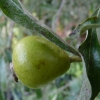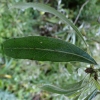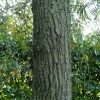Features
In spring there is a pretty display of creamy-white, five petalled flowers with purple pollen on the central appendages. The distinctinve, willow-like, silvery grey leaves last from spring to autumn on long, weeping stems. The inedible, green/brown, ornamental pomes (the fruit) appear in autumn and are typically pear shaped. Mature trees have attractively fissured grey bark.
What to use it for
This elegant plant would make an excellent focal point or taller feature. Once established it is very low maintenance. Due to its slow growth rate and relatively small eventual size, it is a good choice for a small garden.
How to look after it
This pear can suffer from transplant shock, so you should purchase and plant a tree that’s as young as possible to reduce the risk.
Apart from pruning (see below), which is only really needed while the tree is young, this ornamental pear is very low maintenance.
How to prune it
This pear should be pruned from autumn to early spring and should be initially trained to have a central leader with a clear stem of 1.5m so the weeping foliage doesn’t end up lying on the ground. When training the tree, thin out the lateral growth every year to ensure the stems are well and evenly spaced, this will avoid the tree being too crowded when it matures. Once the tree is mature it shouldn’t require any regular pruning except to removed dead, diseased or damaged wood, although you might wish to thin out the stems every now and then. If you do thin it be careful not to create any gaps as established trees are unlikely to put on new growth to fill them. Pears flower on wood grown the previous season, so if you prune too much off you will greatly reduce the flowers and fruit you get that year. Pyrus salicifolia does not respond well to hard pruning, so it’s essential to get the initial training right.
How to propagate it
Budding is the most common method for propagating ornamental pears and should be done in mid to late summer. Chip-budding is used and three scions are budded, evenly spaced, onto the top of a 1.5-2m rootstock (usually of Pyrus communis). If the buds fail to take, a whip-and-tongue graft can be used instead in early spring, removing the failed buds first.
Alternatively seeds can be collected from ripe fruit in mid to late autumn and sown immediately outside, or the seeds can be stored in a refrigerator and sown in late winter. If the seeds have been stored, 6 weeks before sowing you should add water to soak the seeds, keeping them in the refrigerator, for 48 hours. Drain the seeds and then return them to the chiller for the 6 weeks. If any have already germinated when you come to sow them, then lay them onto the surface of the soil and cover with a layer of fine vermiculite. The others can be sown as normal. Cultivars may not come true from seed.
Common problems
Pears can be affected by many different pests, diseases and disorders. For simplicity, we’ve sorted them by the part of the plant which is affected.
Fruit: Birds, capsid bugs, pear midge, brown rot, bitter rot, leathery rots, other minor rots, pear scab, sooty blotch, pear stony pit virus, high temperature injury.
Flowers: Pear sucker, brown rot blossom wilt, bacterial blossom blight, apple bud rot and frost.
Leaves: Aphids, pear leaf blister mite, caterpillars, pear and cherry slugworm, pear ring pattern mosaic virus, pear vein yellows virus, apple powdery mildew, sooty mould, pear scab, leaf-curl, pear leaf fleck, pear rust and frost.
Stems: Rabbits, deer, honey fungus, apple and pear canker, coral spot, crown gall, fireblight, pear bacterial blossom blight, pear decline phytoplasma (also called pear decline), pear blister canker virus and elm heart rot.
General: Pear decline phytoplasma (also called pear decline), replant sickness, nitrogen deficiency, phosphorous deficiency and potassium deficiency.
Other useful information
Pears have been cultivated for many hundreds of years, in fact there is evidence that pears were eaten by prehistoric man and both ancient Greek and Roman writings mention the plant.
This plant has been given the Award of Garden Merit by the RHS.








